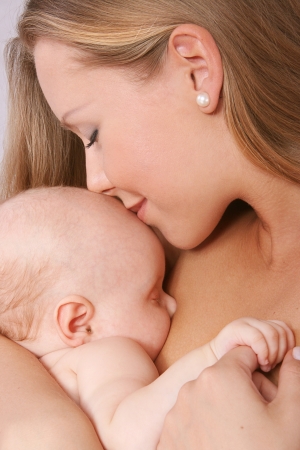1. Understanding Common Baby Allergies
As parents, its important to recognize what can trigger allergic reactions in babies. Allergies can develop due to various factors, including food, environmental elements, and skin irritants. Understanding these common allergens can help you take proactive steps to protect your little one.
Food Allergies
Babies can develop allergies to certain foods, especially when they start eating solids. The most common food allergens include:
| Common Allergen | Examples |
|---|---|
| Dairy | Milk, cheese, yogurt |
| Eggs | Egg whites, egg yolks |
| Nuts | Peanuts, almonds, cashews |
| Wheat | Bread, pasta, cereal |
| Soy | Soy milk, tofu, soy-based products |
| Seafood | Shrimp, fish, shellfish |
Environmental Allergens
Babies can also be sensitive to allergens in their surroundings. Some of the most common environmental triggers include:
- Pollen: Seasonal allergies caused by grass, trees, or flowers.
- Pet Dander: Tiny flakes of skin shed by cats, dogs, or other animals.
- Mold: Found in damp areas like bathrooms or basements.
- Dust Mites: Microscopic creatures that live in bedding and carpets.
Skin Irritants
Certain substances can cause allergic reactions or skin irritation in babies. These may include:
- Soaps and Detergents: Harsh chemicals in laundry detergent or baby wash.
- Lotion and Fragrances: Artificial scents and ingredients that may irritate sensitive skin.
- Fabric Materials: Wool or synthetic fabrics that cause itching or rashes.
Recognizing Allergy Symptoms in Babies
If your baby is exposed to an allergen, they may show signs such as:
- Red or itchy skin rashes (eczema or hives)
- Coughing, sneezing, or congestion
- Tummy troubles like vomiting or diarrhea
- Irritability or excessive fussiness
What to Do Next?
If you suspect your baby has an allergy, consult a pediatrician for guidance on identifying triggers and managing symptoms.
2. Signs and Symptoms of Allergic Reactions
Recognizing an allergic reaction in your baby early is crucial for their health and comfort. Babies cant tell us when something feels wrong, so its important to watch for key indicators. Allergic reactions can affect different parts of the body, including the skin, respiratory system, digestive system, and even behavior.
Common Signs of Baby Allergies
Here are some common symptoms to look out for if you suspect your baby has an allergic reaction:
| Category | Symptoms |
|---|---|
| Skin Reactions | Red rashes, hives, eczema flare-ups, or swelling around the face and lips. |
| Breathing Issues | Wheezing, coughing, nasal congestion, shortness of breath, or difficulty breathing. |
| Digestive Problems | Vomiting, diarrhea, excessive gas, bloating, or colic-like symptoms after eating. |
| Behavioral Changes | Irritability, excessive fussiness, trouble sleeping, or refusal to eat. |
When to Seek Immediate Medical Attention
Mild allergic reactions can often be managed at home with careful monitoring. However, some symptoms require urgent medical care. Call 911 or seek emergency help immediately if your baby experiences:
- Difficulty breathing or wheezing.
- Lips, tongue, or face swelling.
- A sudden drop in activity level or unresponsiveness.
- Persistent vomiting or severe diarrhea leading to dehydration.
- A widespread rash accompanied by fever.
The Importance of Early Recognition
The sooner you recognize an allergic reaction in your baby, the better you can manage it. Keeping a journal of what they eat and any new products they come into contact with can help identify triggers. If symptoms persist or worsen over time, consult a pediatrician for further evaluation and guidance.
![]()
3. Immediate Steps to Take During a Reaction
If your baby is having an allergic reaction, its important to act quickly and calmly. Some reactions are mild, while others may require immediate medical attention. Here’s what you should do depending on the severity of the symptoms.
Recognizing Mild vs. Severe Reactions
Understanding the difference between a mild and severe allergic reaction can help you decide the best course of action. Here’s a quick guide:
| Type of Reaction | Common Symptoms | Recommended Action |
|---|---|---|
| Mild Reaction | – Slight rash or hives – Mild swelling (e.g., around lips or eyes) – Sneezing or runny nose – Mild fussiness |
– Stop exposure to the allergen – Wash affected area with mild soap and water – Apply a cool compress if needed – Give infant-safe antihistamines (if approved by a doctor) – Monitor for worsening symptoms |
| Severe Reaction (Anaphylaxis) | – Difficulty breathing or wheezing – Swelling of face, tongue, or throat – Vomiting or diarrhea after exposure – Extreme fussiness, lethargy, or loss of consciousness |
– Call 911 immediately – Lay baby on their back and elevate legs if possible – Use an epinephrine auto-injector if prescribed – Keep baby calm and monitor breathing until help arrives |
When to Seek Emergency Help
If your baby shows signs of a severe allergic reaction, call 911 right away. Even if symptoms seem to improve, anaphylaxis can have a second wave of symptoms within hours, so medical supervision is essential.
Signs You Should Call 911 Immediately:
- Your baby is having trouble breathing or making wheezing sounds.
- Their face, lips, or tongue are swelling rapidly.
- Your baby is extremely drowsy, unresponsive, or has lost consciousness.
- You notice a sudden drop in blood pressure (pale skin, weak pulse).
- Your baby has severe vomiting or diarrhea along with other allergy symptoms.
Providing First Aid at Home for Mild Reactions
If your baby has only mild symptoms, you can manage them at home with these steps:
How to Soothe Skin Reactions:
- Avoid scratching: Keep your babys nails trimmed to prevent irritation.
- Bathe in lukewarm water: Add oatmeal or fragrance-free soap to calm itching.
- Apply hypoallergenic lotion: Use fragrance-free creams to reduce dryness and irritation.
- Dress in loose clothing: Soft cotton fabrics can help prevent further discomfort.
If Your Baby Ingested an Allergen:
- Stop feeding immediately: Remove any remaining food from their mouth.
- Offer water or breast milk: This may help wash away any remaining allergen.
- Monitor closely: Watch for signs of worsening symptoms over the next few hours.
Preventing Future Allergic Reactions
If your baby has had an allergic reaction before, talk to their pediatrician about testing for allergies and creating an emergency action plan. Avoid known allergens and keep an antihistamine or prescribed medication on hand in case of future reactions.
4. Diagnosing and Managing Baby Allergies
When your baby shows signs of an allergic reaction, its important to understand how pediatricians diagnose allergies and what steps you can take to manage them effectively.
How Pediatricians Diagnose Baby Allergies
Doctors use a combination of testing and observation to determine if your baby has allergies. Since babies cannot verbally describe their symptoms, pediatricians rely on parental reports, medical history, and physical exams. Common diagnostic methods include:
Observation and Symptom Tracking
Pediatricians often start by asking about your babys symptoms, when they occur, and possible triggers. Keeping a symptom diary can help identify patterns.
Allergy Testing
If necessary, doctors may recommend specific allergy tests to confirm their suspicions. These tests include:
| Test Type | Description |
|---|---|
| Skin Prick Test | A small amount of allergens is placed on the skin, and the doctor checks for reactions like redness or swelling. |
| Blood Test | A blood sample is taken to measure the presence of allergy-related antibodies (IgE). |
| Elimination Diet | If food allergies are suspected, certain foods are removed from the babys diet to see if symptoms improve. |
Managing Baby Allergies
If an allergy is diagnosed, there are several strategies to help manage it and keep your baby comfortable.
Avoidance of Triggers
The most effective way to prevent allergic reactions is to limit exposure to known allergens. Here are some common allergens and ways to avoid them:
- Food Allergies: Carefully read ingredient labels and introduce new foods gradually.
- Pollen Allergies: Keep windows closed during high pollen seasons and use air purifiers.
- Dust Mites: Wash bedding frequently in hot water and use allergen-proof covers on mattresses and pillows.
- Pets: If a pet allergy is suspected, try keeping pets out of the babys sleeping area.
Medication for Allergy Relief
If avoidance isnt enough, pediatricians may recommend medications such as:
- Antihistamines: These help reduce itching, swelling, and other allergy symptoms. Always consult a doctor before giving any medication to a baby.
- Epinephrine (for severe allergies): In cases of severe allergic reactions (anaphylaxis), an epinephrine auto-injector may be prescribed.
Create an Allergy Action Plan
If your baby has significant allergies, work with your pediatrician to develop an action plan. This should outline what symptoms to watch for, when to administer medication, and when to seek emergency care.
5. Preventing Future Allergic Reactions
Keeping your baby safe from allergic reactions starts with taking proactive steps to minimize their exposure to allergens. From introducing new foods carefully to creating an allergy-friendly home, here are some practical ways to help prevent future allergic reactions.
Minimizing Exposure to Allergens
Reducing contact with common allergens can make a big difference in preventing reactions. Here are some steps you can take:
- Keep the home clean: Regularly dust and vacuum to remove allergens like pet dander and dust mites.
- Avoid strong fragrances: Perfumes, scented candles, and air fresheners can trigger sensitivities.
- Monitor outdoor allergens: Keep windows closed during high pollen seasons and wash your baby’s hands and face after being outside.
- Select hypoallergenic products: Use fragrance-free lotions, soaps, and detergents designed for sensitive skin.
Introducing New Foods Safely
If your baby is starting solid foods, its important to introduce them in a way that helps identify any potential allergies. Follow these guidelines:
| Step | Description |
|---|---|
| Introduce one food at a time | Offer new foods individually so you can watch for any allergic reactions. |
| Wait 3-5 days between new foods | This allows time to observe any delayed reactions before introducing another food. |
| Avoid high-risk foods early on | If there is a family history of allergies, consult a pediatrician before introducing common allergens like peanuts or eggs. |
| Watch for symptoms | Mild symptoms like rashes or digestive issues should be monitored, while severe reactions require immediate medical attention. |
Creating an Allergy-Friendly Home Environment
A few adjustments around your home can make it a safer space for your baby. Consider these changes:
- Avoid smoking indoors: Secondhand smoke can worsen respiratory allergies and irritate sensitive airways.
- Select allergy-proof bedding: Use dust-mite-proof covers on pillows and mattresses.
- Create pet-free zones: If you have pets, keep them out of the babys nursery to reduce exposure to pet dander.
- Keeps rooms well-ventilated: Use air purifiers and dehumidifiers to improve indoor air quality.
When to See a Doctor
If your baby has frequent allergic reactions despite precautions, consult your pediatrician for advice. They may recommend allergy testing or suggest specific strategies tailored to your childs needs.


